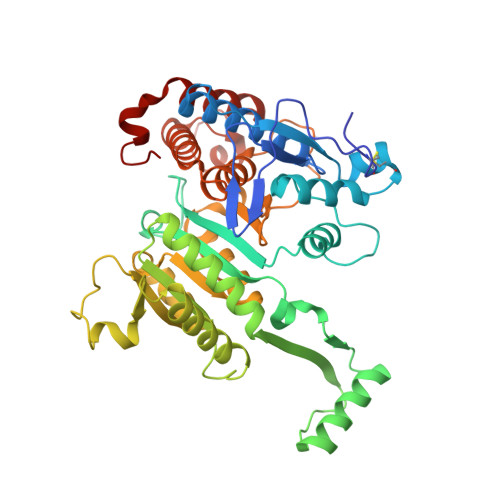Isocitrate dehydrogenase from the hyperthermophile Aeropyrum pernix: X-ray structure analysis of a ternary enzyme-substrate complex and thermal stability
Karlstrom, M., Stokke, R., Steen, I.H., Birkeland, N.-K., Ladenstein, R.(2005) J Mol Biol 345: 559-577
- PubMed: 15581899
- DOI: https://doi.org/10.1016/j.jmb.2004.10.025
- Primary Citation of Related Structures:
1TYO, 1XGV, 1XKD - PubMed Abstract:
Isocitrate dehydrogenase from Aeropyrum pernix (ApIDH) is a homodimeric enzyme that belongs to the beta-decarboxylating dehydrogenase family and is the most thermostable IDH identified. It catalyzes the NADP+ and metal-dependent oxidative decarboxylation of isocitrate to alpha-ketoglutarate. We have solved the crystal structures of a native ApIDH at 2.2 A, a pseudo-native ApIDH at 2.1 A, and of ApIDH in complex with NADP+, Ca2+ and d-isocitrate at 2.3 A. The pseudo-native ApIDH is in complex with etheno-NADP+ which was located at the surface instead of in the active site revealing a novel adenine-nucleotide binding site in ApIDH. The native and the pseudo-native ApIDHs were found in an open conformation, whereas one of the subunits of the ternary complex was closed upon substrate binding. The closed subunit showed a domain rotation of 19 degrees compared to the open subunit. The binding of isocitrate in the closed subunit was identical with that of the binary complex of porcine mitochondrial IDH, whereas the binding of NADP+ was similar to that of the ternary complex of IDH from Escherichiacoli. The reaction mechanism is likely to be conserved in the different IDHs. A proton relay chain involving at least five solvent molecules, the 5'-phosphate group of the nicotinamide-ribose and a coupled lysine-tyrosine pair in the active site, is postulated as essential in both the initial and the final steps of the catalytic reaction of IDH. ApIDH was found to be highly homologous to the mesophilic IDHs and was subjected to a comparative analysis in order to find differences that could explain the large difference in thermostability. Mutational studies revealed that a disulfide bond at the N terminus and a seven-membered inter-domain ionic network at the surface are major determinants for the higher thermostability of ApIDH compared to EcIDH. Furthermore, the total number of ion pairs was dramatically higher in ApIDH compared to the mesophilic IDHs if a cutoff of 4.2 A was used. A calculated net charge of only +1 compared to -19 and -25 in EcIDH and BsIDH, respectively, suggested a high degree of electrostatic optimization, which is known to be an important determinant for increased thermostability.
Organizational Affiliation:
Center for Structural Biochemistry, Department of Biosciences at Novum, Karolinska Institute, S-141 57 Huddinge, Sweden. mikael.karlstrom@csb.ki.se














